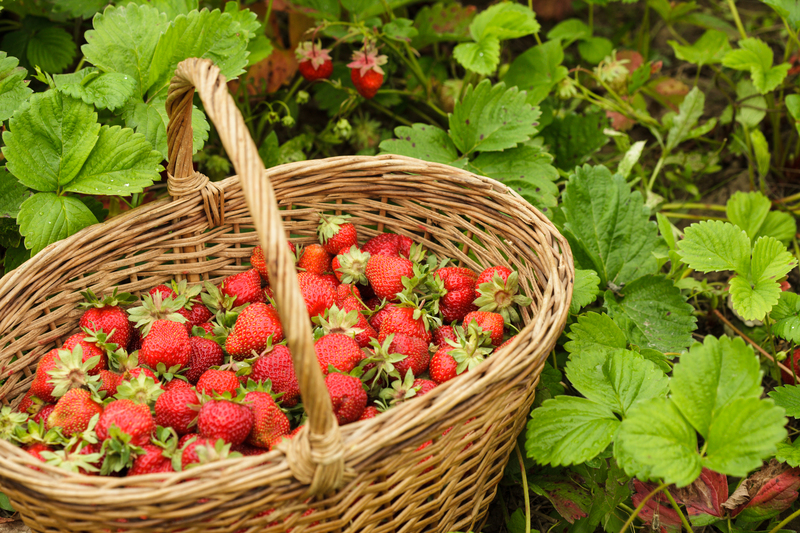Unlocking the Mysteries of Orchid Maintenance
Posted on 26/06/2025
Unlocking the Mysteries of Orchid Maintenance
Orchids have long been seen as symbolic plants, representing beauty, elegance, and sometimes mystery. While their ethereal blooms and varied forms incite curiosity, many plant lovers hesitate to bring orchids into their homes, fearing that their care might be too enigmatic or difficult. The good news is, understanding orchid maintenance is entirely achievable--once you unlock the essential secrets behind their upkeep. In this comprehensive guide, we will demystify orchid care, equip you with actionable tips, and empower you to cultivate thriving, beautiful orchids in your space. Discover how easy it can be to master orchid care and let these exotic wonders flourish in your home.

Why Orchids Fascinate Us: The Allure Behind the Bloom
With over 25,000 species and more than 100,000 hybrids, orchids are one of the largest and most diverse plant families in the world. Their stunning flowers, fascinating growth habits, and unique requirements often set them apart from other houseplants. Orchid enthusiasts aren't just drawn by their beauty, but also by the challenge and reward of successful orchid maintenance. Here's why these elegant plants continue to captivate growers worldwide:
- Diverse shapes, colors, and fragrances make orchids popular among collectors.
- Long-lasting blooms can stay vibrant for weeks or even months under proper care.
- Symbolism and cultural significance in many societies, including love, refinement, and strength.
- Air-purifying abilities contribute to a healthy indoor environment.
Getting Started With Orchid Care: Debunking the Myths
One major myth is that caring for orchids is only for experts. The truth is, with a little knowledge, anyone can enjoy healthy, flowering orchids in their home. The keys lie in understanding their natural habitat, providing the right conditions, and offering consistent, attentive maintenance.
Choosing the Right Orchid for Your Space
Some orchids are easier for beginners than others. Here are popular and forgiving options:
- Phalaenopsis (Moth Orchid): Often recommended for beginners; needs moderate light and tolerates indoor conditions.
- Dendrobium: Adaptable and offers profuse blooms when well-cared for.
- Cattleya: Known for colorful, fragrant flowers; needs a bit more light but rewards with spectacular displays.
- Oncidium: Enjoys filtered light and offers unique, "dancing lady" blooms.
Understanding Orchid Needs: The Basics
- Light: Most orchids require bright, indirect light. Direct sunlight can scorch the leaves, while too little light can result in poor blooming.
- Temperature: Orchids generally prefer temperatures between 65?F-80?F (18?C-27?C) during the day and a slight decline at night.
- Humidity: 40%-70% relative humidity is ideal for most orchids. Low indoor humidity may require trays of water or a humidifier.
- Water: Overwatering is a leading cause of orchid problems. Orchids prefer to dry slightly between waterings.
- Soil/Medium: Orchids do not grow in typical potting soil. They thrive in bark, sphagnum moss, or specialized orchid mixes that provide aeration and drainage.
Orchid Maintenance Essentials: Nurturing Healthy Growth
Mastering Light Requirements
The key to vibrant orchid blooms is correct lighting. Orchids naturally grow in filtered sunlight, beneath the forest canopy. Recreate this by placing your orchid near an east or south-facing window, where it will receive indirect light. Leaves should be a light, grassy green; dark green indicates too little light, while yellowing or red-tinged leaves mean too much.
- Sheer curtains can diffuse direct sunlight.
- Supplemental grow lights work well if space lacks natural light.
The Art of Watering Orchids
Understanding when and how to water orchids separates thriving plants from those that struggle. Every species is different, but most houseplant orchids need water about once a week. To test if your orchid needs water, insert a fingertip or wooden stick into the potting medium--it should feel slightly dry before rewatering.
- Avoid letting pots sit in standing water, which promotes root rot.
- Use room temperature, distilled, or rainwater to avoid chemical build-up from tap water.
- Fully saturate the potting medium, then let it drain completely before returning it to its saucer or tray.
Feeding Orchids: Fertilizer Fundamentals
Orchids have specific feeding needs. While they don't need a lot of fertilizer, providing the right nutrients encourages robust growth and bloom production. Use a balanced, water-soluble orchid fertilizer (such as 20-20-20) at half-strength every 2-4 weeks during the growing season.
- "Weakly, weekly": Fertilize with a weak solution at each watering.
- Flush the potting medium once a month with plain water to prevent salt accumulation.
- Reduce feeding during winter dormancy.
Temperature and Humidity Tips
To emulate their tropical origins, orchids appreciate a room temperature climate and higher humidity. Some practical actions include:
- Group plants together to create a moist microclimate.
- Place pots on trays filled with pebbles and water (water should not touch the bottom of the pot).
- Use a cool-mist humidifier if your air is dry, especially in winter.
Repotting: Keeping Orchids Happy
Orchids need to be repotted every 1-3 years to renew their potting medium and prevent root suffocation. Signs it's time to repot include:
- Outgrown their container
- Medium decomposing or smells musty
- Roots circling the surface or poking out the bottom
Repotting Tips:
- Choose a pot only slightly larger than the previous one.
- Use only fresh, appropriate orchid mix.
- Trim away dead or mushy roots before replanting.
- Water sparingly for a week after repotting to help roots establish.
Common Orchid Problems and Solutions
Leaf Issues
- Yellow Leaves: Typically from overwatering, poor drainage, or too much sunlight. Adjust light and watering schedule.
- Wrinkled or Limp Leaves: Underwatering or extensive root damage. Check roots and watering habits.
- Spots or Mold: Fungal or bacterial infections. Remove affected leaves with sterilized scissors and adjust humidity.
Budding and Flowering Problems
- Failure to Bloom: Often caused by insufficient light, improper feeding, or temperature issues. Increase light or ensure proper "resting" periods in winter.
- Buds Falling Off (Bud Blast): Can be triggered by sudden environmental changes like temperature drops, drafts, or dry air. Maintain consistent conditions.
Pest Infestations
- Mealybugs, scale, and spider mites are common orchid pests. Remove them by gently wiping with alcohol-dipped cotton swabs or use insecticidal soap.
- Inspect new plants closely before introducing them to your collection.
Advanced Orchid Maintenance: Boosting Blooms and Longevity
Simulating a Natural Environment
The happiest orchids are those closest to their wild origins. As you grow confident, try mimicking nature:
- Give them a day-night temperature drop (5-10?F) to stimulate flowering.
- Rotate your orchids periodically to ensure balanced leaf growth.
- Gently clean leaves with a damp cloth to maximize photosynthesis.
Reblooming Tips and Tricks
Many people discard orchids after blooms fade, not realizing they can bloom again and again. To encourage reblooming:
- Cut spent flower spikes just above a visible node or near the base, depending on the species.
- Resume normal feeding and watering after a brief rest period.
- Patience is key: Reblooming can take several months but is highly rewarding!
Orchid Maintenance for Different Life Stages
- Seedling: Needs higher humidity, more frequent but gentle watering, and protection from strong light.
- Mature plants: Benefit from regular feeding, occasional repotting, and strategic pruning.
- Older, established orchids: May bloom less frequently; focus on freshening the potting mix and maintaining optimal conditions.
Frequently Asked Questions About Orchid Maintenance
How do I know when to water my orchid?
The best way is to feel the potting medium. If it's dry an inch below the surface, it's time to water. Avoid watering by schedule alone; adjust based on humidity, temperature, and pot size.
What's the secret to getting my orchid to bloom again?
Provide bright, indirect light, feed regularly (except during dormancy), and ensure a nighttime temperature drop. After blooming, continue care; orchids need a resting phase before producing new flower spikes.
Is my home humid enough for orchids?
Most homes are drier than orchids prefer, especially with winter heating. Use a humidity tray, group plants, or run a humidifier to reach 40-70% relative humidity.
Why are my orchid's roots growing outside the pot?
These are aerial roots, a natural adaptation. They help absorb moisture and nutrients from the air. As long as they are firm and green or white, they're healthy. Don't trim them unless they are shriveled or dead.

Orchid Maintenance: Unlocking Rewards Beyond the Mystery
While orchid maintenance may seem mysterious at first, it becomes intuitive with practice and observation. Learning the specific needs of your orchid--from light and water to potting and feeding--makes all the difference between frustration and flourishing. Orchids reward attentive care with breathtaking blooms and ongoing growth, transforming your home into a haven of exotic beauty.
- Start with easy varieties and gain experience as you go.
- Observe your plants closely; orchids communicate their needs through their leaves and roots.
- Don't fear mistakes: they're part of the learning process!
Unlocking the mysteries of orchid maintenance is less about following rigid rules and more about fostering a relationship with these remarkable plants. With time, patience, and the comprehensive tips in this guide, you'll transform orchid care into an enjoyable--and highly rewarding--journey.
Your Orchid Adventure Awaits
Let your home become a stage for the elegance and wonder of the orchid family. Whether you're a beginner or a seasoned gardener, the secrets to orchid health and maintenance are now in your hands. Experiment, observe, and enjoy every step of your orchid adventure. With each new leaf and spike, you're unlocking not just the mysteries of orchid maintenance, but the immense satisfaction that comes from growing the world's most exquisite flowering plants.

